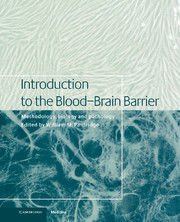Book contents
- Frontmatter
- Contents
- List of contributors
- 1 Blood–brain barrier methodology and biology
- Part I Methodology
- Part II Transport biology
- 18 Biology of the blood–brain glucose transporter
- 19 Glucose transporters in mammalian brain development
- 20 Blood–brain barrier amino acid transport
- 21 P-glycoprotein, a guardian of the brain
- 22 Blood–brain barrier ion transport
- 23 Ion channels in endothelial cells
- 24 Interactions of lipoproteins with the blood–brain barrier
- 25 Fatty acid and lipid intermediate transport
- 26 Blood–brain barrier transport of drugs
- Part III General aspects of CNS transport
- Part IV Signal transduction/biochemical aspects
- Part V Pathophysiology in disease states
- Index
26 - Blood–brain barrier transport of drugs
from Part II - Transport biology
Published online by Cambridge University Press: 10 December 2009
- Frontmatter
- Contents
- List of contributors
- 1 Blood–brain barrier methodology and biology
- Part I Methodology
- Part II Transport biology
- 18 Biology of the blood–brain glucose transporter
- 19 Glucose transporters in mammalian brain development
- 20 Blood–brain barrier amino acid transport
- 21 P-glycoprotein, a guardian of the brain
- 22 Blood–brain barrier ion transport
- 23 Ion channels in endothelial cells
- 24 Interactions of lipoproteins with the blood–brain barrier
- 25 Fatty acid and lipid intermediate transport
- 26 Blood–brain barrier transport of drugs
- Part III General aspects of CNS transport
- Part IV Signal transduction/biochemical aspects
- Part V Pathophysiology in disease states
- Index
Summary
Introduction
The ability to permeate across the blood–brain barrier (BBB) is essential for drugs acting on the central nervous system (CNS), whereas for peripherally acting drugs negligible penetration across the BBB is preferable to avoid CNS side-effects. Transfers of compounds from the circulating blood into the brain interstitial fluid are strictly regulated by the function of brain capillary endothelial cells, which are lined by tight intercellular junctions, lacking fenestrae, and make up the BBB in vivo.
This chapter summarizes the mechanisms regulating the influx and efflux processes of drugs, including large peptides, at the BBB in order to understand the net drug transport into the brain, and describes possible strategies to regulate drug entry into the brain, not by lipid-mediated transport, but by utilizing specific transport systems expressed at the brain capillary endothelial cell membrane. This is not intended to be a comprehensive review of the literature on drug delivery into the brain: readers are referred to recent review articles for more detailed information (Cornford, 1985; Pardridge, 1991, 1995a,b; Banks et al., 1992; Terasaki and Tsuji, 1994, 1995; Bergley, 1996; Border and Prokai, 1995; Zlokovic, 1995; Tamai and Tsuji, 1996; Tsuji and Tamai, 1997).
- Type
- Chapter
- Information
- Introduction to the Blood-Brain BarrierMethodology, Biology and Pathology, pp. 238 - 248Publisher: Cambridge University PressPrint publication year: 1998
- 8
- Cited by



